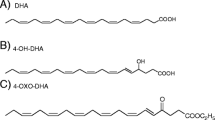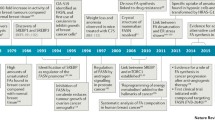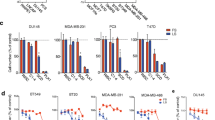Abstract
To gain some insight into the mechanisms involved in the opposing effects of linoleic acid (LA) and eicosapentaenoic acid (EPA) on the growth and invasiveness of MDA-MB-435 human breast cancer cells, the dynamics of the uptake by cells and the incorporation of [14C]LA and [14C]EPA into major lipid and phospholipid pools, as well as the effects of unlabeled EPA or LA on the uptake and distribution of [14C]LA or [14C]EPA, respectively, were examined. Cells were exposed to [14C]LA (1.28 μg/mL) or [14C]EPA (1.0 μg/mL) and unlabeled EPA or LA, respectively, at 0, 1, 4 and 16 μg/mL for 24 h in serum-free media. The uptake of each fatty acid (FA) was linear over time and was not affected by the presence of the opposing FA. For both FA, 80–90% was incorporated into the phospholipid fraction with the remaining 10–20% in neutral lipids. The relative distribution profile of [14C]LA among the phospholipid classes indicated a preferential incorporation into phosphatidylcholine (65%), whereas [14C]EPA was mostly found in phosphatidylethanolamine (58%). In the presence of unlabeled EPA or LA at various concentrations, corresponding dose-dependent shifts of [14C]LA or [14C]EPA from the phospholipid to the neutral lipid pool were noted, which did not alter the relative distribution of the FA among the phospholipid classes. Exogenous exposure to EPA or LA increased its content in membrane phospholipids while concurrently decreasing LA or EPA content, respectively, in a dose-dependent manner. Arachidonic acid content of membrane phospholipids remained constant. The divergent distribution profiles of LA and EPA within the phospholipid compartment provides some insight into the mechanisms of their opposing effects on MDA-MB-435 cell growth and invasiveness. Also, the effects of LA and EPA on the uptake and distribution of their opposing FA shed some light on the mechanisms mediating their competitive effects.
Similar content being viewed by others
Abbreviations
- AA:
-
arachidonic acid
- ANOVA:
-
analysis of variance
- BSA:
-
bovine serum albumin
- DHA:
-
docosahexaenoic acid
- EPA:
-
eicosapentaenoic acid
- FA:
-
fatty acid(s)
- FBS:
-
fetal bovine serum
- HETE:
-
hydroxyeicosatetraenoic acid
- IMDM:
-
Iscove's modified Dulbecco's medium
- LA:
-
linoleic acid
- PC:
-
phosphatidylcholine
- PE:
-
phosphatidylethanolamine
- PI:
-
phosphatidylinositol
- PLA2 :
-
phospholipase A2
- PS:
-
phosphatidylserine
- TLC:
-
thin-layer chromatography
References
Carroll, K.K. (1975)Cancer Res. 35, 3374–3383.
Cohen, L.A., Thompson, D.O., Choi, K., Blank, M.E., and Rose, D.P. (1986)J. Natl. Cancer. Inst. 77, 33–42.
Jurkowski, J.J., and Cave, Jr., W.T. (1985)J. Natl. Cancer Inst. 74, 1145–1150.
Abou-El-Ela, S.H., Prasse, K.W., Farrell, R.L., Carroll, R.W., Wade, A.S., and Bunce, O.R. (1989)Cancer Res. 49, 1434–1440.
Rao, G.A., and Abraham, S. (1977)J. Natl. Cancer Inst. 58, 445–447.
Abraham, S., and Hillyard, L.A. (1983)J. Natl. Cancer Inst. 71, 601–605.
Karmali, R.A., Marsh, J., and Fuchs, C. (1984)J. Natl. Cancer Inst. 73, 457–461.
Gabor, H., and Abraham, S. (1986)J. Natl. Cancer Inst. 76, 1223–1229.
Rose, D.P., and Connolly, J.M. (1989)Biochem. Biophys. Res. Commun. 64, 277–283.
Rose, D.P., and Connolly, J.M. (1990)Cancer Res. 50, 7139–7144.
Connolly, J.M., and Rose, D.P. (1993)Cancer Lett. 75, 137–142.
Connolly, J.M., and Rose, D.P. (1994)Proc. Assoc. Cancer Res. 35, 52.
Rose, D.P., Connolly, J.M., and Meschter, C.L. (1991)J. Natl. Cancer Inst. 83, 1491–1495.
Rose, D.P., Hatala, M.A., Connolly, J.M., and Rayburn, J.M. (1993)J. Cancer Res. 53, 4686–4690.
Rose, D.P., and Connolly, J.M. (1993)J. Natl. Cancer Inst. 85, 1743–1747.
Ashendel, C.L. (1992) inCellular and Molecular Targets for Chemoprevention (Steele, V.E., Stoner, G.D., Boone, C.W., and Kelloff, G.J., eds.) pp. 19–41, CRC Press, Boca Raton.
Cullis, P.R., and Hope, M.J. (1985) inBiochemistry of Lipids and Membranes (Vance, D.E., and Vance, J.E., eds.) pp. 25–30, Benjamin/Cummings Publishing Co., Menlo Park.
Burns, C.P., and Spector, A.A. (1990)Nutr. Rev. 48, 233–240.
Leger, C.L. (1993)Prostaglandins Leukot. Essent. Fatty Acids 48, 17–21.
Price, J.E., Polyzos, A., Zhang, R.D., and Daniels, L.M. (1990)Cancer Res. 50, 717–721.
Bligh, E.G., and Dyer, W.J. (1959)Can. J. Biochem. Physiol. 37, 911–917.
Leyton, J., Lee, M.L., Locniskar, M., Belury, M.A., Slaga, T.G., Bechtel, D., and Fischer, S.M. (1991)Cancer Res. 51, 907–915.
Folch, J., Lees, M., and Sloane-Stanley, G.H. (1957)J. Biol. Chem. 226, 497–509.
Lepage, G., and Roy, C.C. (1986)J. Lipid Res. 27, 114–120.
Cook, H.W., Clarke, J.T.R., and Spence, M.W. (1983)J. Biol. Chem. 258, 7586–7591.
Miller, M., Motevalli, M., Westphal, D., and Kwiterovich, Jr. P.O. (1993)Lipids 28, 1–5.
Marcelo, C.L., and Dunham, W.R. (1993)J. Lipid Res. 34, 2077–2090.
Takahashi, R., Begin, M.E., Ells, G., and Horrobin, D.F. (1991)Prostaglandins Leukot. Essent. Fatty Acids 42, 113–117.
Pazouki, S., Baty, J.D., Wallace, H.M., and Coleman, C.S. (1992)Lipids 27, 827–834.
Gaspar, G., de Alaniz, M.J.T., and Brenner, R.R. (1975)Lipids 10, 726–731.
Hubbard, N.E., and Erickson, K.L. (1987)Cancer Res. 47, 6171–6175.
Rose, D.P., Rayburn, J., Hatala, M.A., and Connolly, J.M. (1994)Nutr. Cancer 22, 131–141.
Spector, A.A., and Yorek, M.A. (1985)J. Lipid Res. 26, 1015–1035.
Spector, A.A., and Burns, C.P. (1987)Cancer Res. 57, 4529–4537.
Cave, Jr., W.T., and Erickson-Lucas, M.J. (1982)J. Natl. Cancer Inst. 68, 319–324.
Author information
Authors and Affiliations
About this article
Cite this article
Hatala, M.A., Rayburn, J. & Rose, D.P. Comparison of linoleic acid and eicosapentaenoic acid incorporation into human breast cancer cells. Lipids 29, 831–837 (1994). https://doi.org/10.1007/BF02536250
Received:
Revised:
Accepted:
Published:
Issue Date:
DOI: https://doi.org/10.1007/BF02536250




